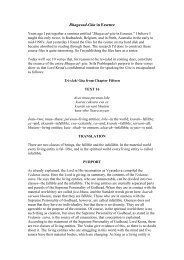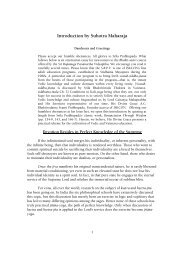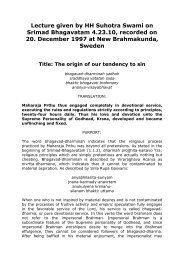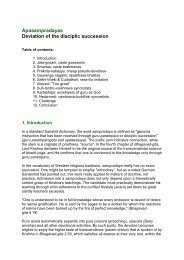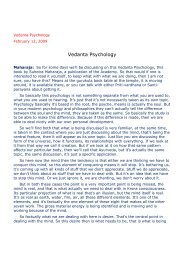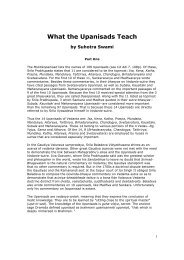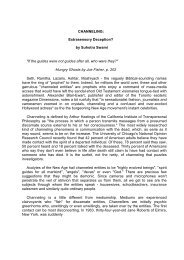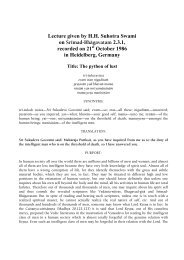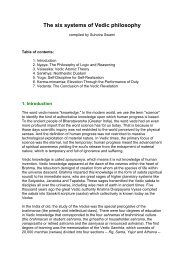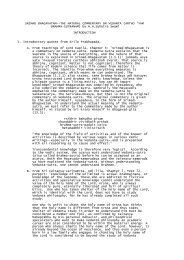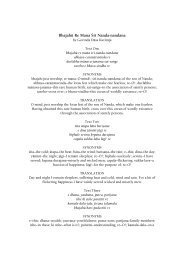Indologist and Sanskritist at the Uni Bonn who is fully trained up in Mayavadiphilosophy, and yet (up to a few years ago, anyway) is friendly to devotees.2) Keeping a book in a library is one thing; allowing devotees to study it isanother. Lord Caitanya said *mayavadi bhasya sunile haya sarva nash*, "hearingthe Mayavadi bhasya of Sankara brings spiritual destruction."3) This is a big question. As an answer, I'll put here a text I wrote for theISKCON Homepage on the internet World Wide Web. It briefly compares the Vedantadoctrines of the 4 Vaisnava sampradayas with Lord Caitanya's sampradaya.Personal vs. Impersonal Vedanta, and the Four Vaisnava SampradayasWhat is Vedanta?The highest degree of Vedic education, traditionally reserved for the sannyasis(renunciates), is mastery of the texts known as the Upanisads. The Upanisadsteach the philosophy of the Absolute Truth (Brahman) to those seeking liberationfrom birth and death. Study of the Upanisads is known as Vedanta, `theconclusion of the Veda.' The word *upanisad* means `that which is learned bysitting close to the teacher.' The texts of the Upanisads are extremelydifficult to fathom; they are to be understood only under the close guidance ofa spiritual master (guru). Because the Upanisads contain many apparentlycontradictory statements, the great sage Vyasadeva (also known as Vedavyasa,Badarayana and Dvaipayana) systematized the Upanisadic teachings in the Vedantasutraor Brahma-sutra. Vyasa's sutras are very terse. Without a fullerexplanation, their meaning is difficult to grasp. In India there are five mainschools of Vedanta, each established by an acarya (founder) who explained thesutras in a bhasya (commentary).Of the five schools, one, namely Adi Sankara's, is impersonalist. Sankara taughtthat Brahman has no name, form nor personál characteristics. His school isopposed by the four Vaisnava sampradayas founded by Ramanuja, Madhva, Nimbarkaand Visnusvami. Unlike the impersonalist school, Vaisnava Vedanta admits thevalidity of Vedic statements that establish difference (bheda) within Brahman,as well those that establish nondifference (abheda). Taking the bheda andabheda statements together, the Vaisnava Vedantists distinguish between threefeatures of the one Vastu Brahman (Divine Substance): 1) Visnu as the SupremeSoul (Para Brahman), 2) the individual self as the subordinate soul (JivaBrahman), and 3) matter as creative nature (Mahad Brahman). The philosophies ofthe four Vaisnava sampradayas dispel the sense of mundane limitation ordinarilyassociated with the word `person.' Visnu is accepted by all schools of VaisnavaVedanta as the transcendental, unlimited Purusottama (Supreme Person), while theindividual souls and matter are His conscious and unconscious energies (cidacidsakti).What is Siddhanta?Each of the Vedantist schools is known for its siddhanta or `essentialconclusion' about the relationships between God and the soul, the soul andmatter, matter and matter, matter and God, and the soul and souls. Sankara'ssiddhanta is Advaita, `nondifference' (i.e. everything is one, therefore thesefive relationships are unreal). All the other siddhantas support the reality ofthese relationships from various points of view. Ramanuja's siddhanta isVisistadvaita, `qualified nondifference.' Madhva's siddhanta is Dvaita,`difference.' Visnusvami's siddhanta is Suddhadvaita, `purified nondifference.'And Nimbarka's siddhanta is Dvaita-advaita, `difference-and-identity.'The Bengali branch of Madhva's sampradaya is known as the Brahma- Madhva-GaudiyaSampradaya, or the Caitanya Sampradaya. In the 1700's this school presentedIndian philosophers with a commentary on Vedanta-sutra written by Baladeva
Vidyabhusana that argued yet another siddhanta. It is called Acintyabhedabheda-tattva,which means `simultaneous inconceivable oneness anddifference.' In recent years this siddhanta has become known to people from allover the world due to the popularity of the books of His Divine Grace A.C.Bhaktivedanta Swami Prabhupada. Acintya-bhedabheda philosophy maintains thesame standpoint of `difference' as Madhva's siddhanta on the five-foldrelationship of God to soul, soul to matter, matter to matter, matter to God andsoul to soul. But Acintya-bhedabheda-tattva further teaches the doctrine ofSaktiparinamavada (the transformation of the Lord's sakti), in which the originof this five-fold differentiation is traced to the Lord's play with His sakti orenergy. Because the souls and matter emanate from the Lord, they are one in Himas His energy yet simultaneously distinct from Him and one another. The onenessand difference of this five-fold relationship is termed acintya or inconceivablebecause, as Srila Prabhupada writes in his purport to Bhagavad-gita 18.78,`Nothing is different from the Supreme, but the Supreme is always different fromeverything.' As the transcendental origin and coordinator of His energies, Godis ever the inconceivable factor.Differences among the four Vaisnava SampradayasThe four Vaisnava sampradayas all agree that Visnu is the cause. However, theyexplain His relationship with His creation differently. In Visistadvaita, thematerial world is said to be the body of Visnu, the Supreme Soul. But theDvaita school does not agree that matter is connected to Visnu as body is tosoul, because Visnu, God, is transcendental to matter. The world of matter isfull of misery, but since Vedanta-sutra 1.1.12 defines God as anandamaya(abundantly blissful), how can nonblissful matter be His body? The truthaccording to the Dvaita school is that matter is ever separate from Visnu butyet is eternally dependent upon Visnu; by God's will, says the Dvaita school,matter becomes the ingredient cause of the world. The Suddhadvaita schoolcannot agrese with the Dvaita school that matter is the ingredient cause becausematter has no independent origin apart from God. Matter is actually notdifferent from God in the same way an effect is not different from its cause,although there is an appearance of difference. The example of the ocean and itswaves is given by Suddhadvaita philosophers to illustrate their argument thatthe cause (the ocean) is the same as the effect (the waves). The Dvaitadvaitaschool agrees that God is both the cause and effect, but is dissatisfied withthe Suddhadvaita school's standpoint that there is really no difference betweenGod and the world. The Dvaitadvaita school says that God is neither one withnor different from the world--He is both. A snake, the Dvaitadvaita schoulargues, can neither be said to have a coiled form or a straight form. It hasboth forms. Similarly, God's `coiled form' is His transcendental non-materialaspect, and His `straight form' is His mundane aspect. But this explanation isnot without its problems. If God's personal nature is eternity, knowledge andbliss, how can the material world, which is temporary, full of ignorance andmiserable, be said to be just another form of God?Reconciliation of the four Vaisnava viewpointsThe Caitanya school reconciles these seemingly disparate views of God'srelationship to the world by arguing that the Vedic scriptures testify to God'sacintya-sakti, `inconceivable powers.' God is simultaneously the cause of theworld in every sense and yet distinct from and transcendental to the world. Theexample given is of a spider and its web. The web emanates from the spider'sbody, so the spider may be taken as the ingredient cause of the web. But thatdoes not make the spider and the web one and the same. The spider is always aseparate and distinct entity from its web. Yet again, while the spider never`is' the web, the existence of the web cannot be separated from the spider.There is a further lesson to be learned from this example: while the spider isclearly different from its web-creation, it nontheless is acutely conscious ofevery corner of it. In philosophical terms, we could say the spider is
- Page 1 and 2:
DANDA1995Questions and AnswerswithH
- Page 3 and 4:
I have already replied to the argum
- Page 5 and 6:
Similarly, in an ISKCON temple, a d
- Page 7 and 8:
even be well-intentioned (let the c
- Page 9 and 10:
Answer by Suhotra SwamiJanuary 15,
- Page 11 and 12: Comment by Vipramukhya SwamiI've me
- Page 13 and 14: i.e. his visible form).to.In the pr
- Page 15 and 16: 1. The self-realization stage just
- Page 17 and 18: ksatriya families worshiped Radha-K
- Page 19 and 20: are banished from Kailasa by being
- Page 21 and 22: always in competition with each oth
- Page 23 and 24: Was that enough, Bhakta Jan? No? OK
- Page 25 and 26: prakampanaloka-gurusrastaparasmai t
- Page 27 and 28: That's they quoted from me.In the c
- Page 29 and 30: to tell how he was abducted to anot
- Page 31 and 32: to come, and these ten avatars corr
- Page 33 and 34: emember and speak the best that has
- Page 35 and 36: devotees, but I gave them as exampl
- Page 37 and 38: CAITANYA UPANISADQuestion from Mukh
- Page 39 and 40: for that. So that... This is going
- Page 41 and 42: A footnote to the previous text:It
- Page 43 and 44: other planets encircle the polestar
- Page 45 and 46: TIME PERCEPTIONQuestions from Rohit
- Page 47 and 48: Answer by Suhotra SwamiJune 27, 199
- Page 49 and 50: connected to the Lord's body. And B
- Page 51 and 52: - How to understand there was no cr
- Page 53 and 54: SB 6.14.55 p., 1st par.: The subtle
- Page 55 and 56: could not even get that. And they l
- Page 57 and 58: "Krsna is the supreme living being.
- Page 59 and 60: Answer by Suhotra SwamiSeptember 26
- Page 61: Answer by Suhotra SwamiOctober 11,
- Page 65 and 66: SELF-ENVYQuestions from Vrajendra K
- Page 67 and 68: I was studying the second canto cha
- Page 69 and 70: Answer by Suhotra SwamiNovember 11,
- Page 71 and 72: Answer by Suhotra SwamiNovember 11,
- Page 73 and 74: ATHEISMQuestion from Jahnu dasNovem
- Page 75 and 76: two years old and under, in accorda
- Page 77 and 78: that sense one would think the exte
- Page 79 and 80: 1) Yes, the message of Jesus is uni
- Page 81 and 82: Paul rationalized that Jesus surviv
- Page 83 and 84: The publication I am working on in
- Page 85 and 86: - From the context of the second qu
- Page 87 and 88: Dear Maharaja,I see that it is a qu
- Page 89: associates, etc. Lord Vamana has Hi



